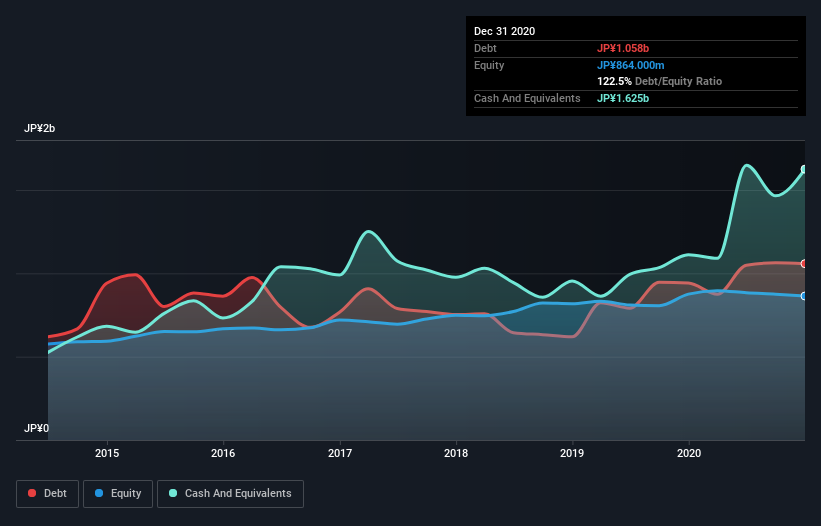
Howard Marks put it nicely when he said that, rather than worrying about share price volatility, 'The possibility of permanent loss is the risk I worry about... and every practical investor I know worries about.' So it might be obvious that you need to consider debt, when you think about how risky any given stock is, because too much debt can sink a company. Importantly, Emergency Assistance Japan Co., Ltd. (TYO:6063) does carry debt. But is this debt a concern to shareholders?
When Is Debt Dangerous?
Generally speaking, debt only becomes a real problem when a company can't easily pay it off, either by raising capital or with its own cash flow. If things get really bad, the lenders can take control of the business. While that is not too common, we often do see indebted companies permanently diluting shareholders because lenders force them to raise capital at a distressed price. By replacing dilution, though, debt can be an extremely good tool for businesses that need capital to invest in growth at high rates of return. The first thing to do when considering how much debt a business uses is to look at its cash and debt together.
View our latest analysis for Emergency Assistance Japan
What Is Emergency Assistance Japan's Net Debt?
You can click the graphic below for the historical numbers, but it shows that as of December 2020 Emergency Assistance Japan had JP¥1.06b of debt, an increase on JP¥942.0m, over one year. But on the other hand it also has JP¥1.63b in cash, leading to a JP¥567.0m net cash position.

How Strong Is Emergency Assistance Japan's Balance Sheet?
The latest balance sheet data shows that Emergency Assistance Japan had liabilities of JP¥1.72b due within a year, and liabilities of JP¥61.0m falling due after that. Offsetting these obligations, it had cash of JP¥1.63b as well as receivables valued at JP¥102.0m due within 12 months. So its liabilities total JP¥52.0m more than the combination of its cash and short-term receivables.
This state of affairs indicates that Emergency Assistance Japan's balance sheet looks quite solid, as its total liabilities are just about equal to its liquid assets. So it's very unlikely that the JP¥3.73b company is short on cash, but still worth keeping an eye on the balance sheet. While it does have liabilities worth noting, Emergency Assistance Japan also has more cash than debt, so we're pretty confident it can manage its debt safely.
Shareholders should be aware that Emergency Assistance Japan's EBIT was down 81% last year. If that earnings trend continues then paying off its debt will be about as easy as herding cats on to a roller coaster. There's no doubt that we learn most about debt from the balance sheet. But it is Emergency Assistance Japan's earnings that will influence how the balance sheet holds up in the future. So when considering debt, it's definitely worth looking at the earnings trend. Click here for an interactive snapshot.
But our final consideration is also important, because a company cannot pay debt with paper profits; it needs cold hard cash. While Emergency Assistance Japan has net cash on its balance sheet, it's still worth taking a look at its ability to convert earnings before interest and tax (EBIT) to free cash flow, to help us understand how quickly it is building (or eroding) that cash balance. Happily for any shareholders, Emergency Assistance Japan actually produced more free cash flow than EBIT over the last three years. That sort of strong cash generation warms our hearts like a puppy in a bumblebee suit.
Summing up
We could understand if investors are concerned about Emergency Assistance Japan's liabilities, but we can be reassured by the fact it has has net cash of JP¥567.0m. The cherry on top was that in converted 154% of that EBIT to free cash flow, bringing in JP¥388m. So we are not troubled with Emergency Assistance Japan's debt use. The balance sheet is clearly the area to focus on when you are analysing debt. But ultimately, every company can contain risks that exist outside of the balance sheet. For example, we've discovered 4 warning signs for Emergency Assistance Japan (2 make us uncomfortable!) that you should be aware of before investing here.
When all is said and done, sometimes its easier to focus on companies that don't even need debt. Readers can access a list of growth stocks with zero net debt 100% free, right now.
If you’re looking to trade a wide range of investments, open an account with the lowest-cost* platform trusted by professionals, Interactive Brokers. Their clients from over 200 countries and territories trade stocks, options, futures, forex, bonds and funds worldwide from a single integrated account. Promoted
Valuation is complex, but we're here to simplify it.
Discover if Emergency Assistance Japan might be undervalued or overvalued with our detailed analysis, featuring fair value estimates, potential risks, dividends, insider trades, and its financial condition.
Access Free AnalysisThis article by Simply Wall St is general in nature. It does not constitute a recommendation to buy or sell any stock, and does not take account of your objectives, or your financial situation. We aim to bring you long-term focused analysis driven by fundamental data. Note that our analysis may not factor in the latest price-sensitive company announcements or qualitative material. Simply Wall St has no position in any stocks mentioned.
*Interactive Brokers Rated Lowest Cost Broker by StockBrokers.com Annual Online Review 2020
Have feedback on this article? Concerned about the content? Get in touch with us directly. Alternatively, email editorial-team (at) simplywallst.com.
About TSE:6063
Emergency Assistance Japan
Provides medical and lifestyle assistance services in Japan and internationally.
Excellent balance sheet slight.
Market Insights
Community Narratives



